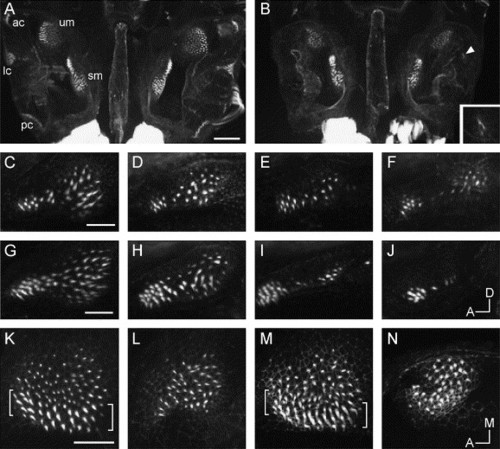Fig. 4
- ID
- ZDB-FIG-071005-33
- Publication
- Kozlowski et al., 2005 - The zebrafish dog-eared mutation disrupts eya1, a gene required for cell survival and differentiation in the inner ear and lateral line
- Other Figures
- All Figure Page
- Back to All Figure Page
|
Sensory patch phenotype in the ears of dog-eared homozygous embryos; confocal images of embryos and larvae stained with FITC-phalloidin. (A) Dorsal view (anterior to top) of a dissected preparation of the two ears of a 5 dpf wild-type sibling larva showing five distinct sensory patches in each ear: the utricular and saccular maculae (um, sm), and the anterior, lateral, and posterior cristae (ac, lc, pc). Scale bar, 50 μm. (B) The ears of a dogtm90b homozygote. Hair cells of the cristae are not visible in the left ear; in the right ear, three hair cells are present in the region where the lateral crista would normally form (magnified in inset). (C?J) Abnormalities in the saccular macula (orientation shown in J: anterior to left, dorsal to top): (C) lateral view of wild type, 3 dpf; (D?F) examples of saccular maculae from dogtm90b homozygous mutants, 3 dpf; (G) wild type, 5 dpf; (H?J) examples of saccular maculae from dogtm90b homozygous mutants, 5 dpf. Scale bar, 20 μm. (K?N) Abnormalities in the utricular macula (orientation shown in N: anterior to left, medial to top): (K and M) dorsal views of utricular maculae from phenotypically wild-type siblings, 5.5 dpf; (L) dogtm90b homozygote, 5.5 dpf; (N) dogtp85b homozygote, 5.5 dpf. Brackets to the left and right of the wild-type maculae shown in K and M indicate the hair cells with long stereociliary bundles located at the lateral edges of the maculae; this type of hair cell is mostly absent in the maculae of dog embryos (L and N). Scale bar, 20 μm. |
Reprinted from Developmental Biology, 277(1), Kozlowski, D.J., Whitfield, T.T., Hukriede, N.A., Lam, W.K., and Weinberg, E.S., The zebrafish dog-eared mutation disrupts eya1, a gene required for cell survival and differentiation in the inner ear and lateral line, 27-41, Copyright (2005) with permission from Elsevier. Full text @ Dev. Biol.

